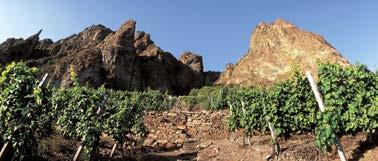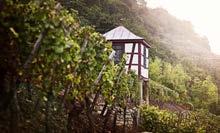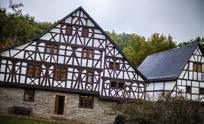
7 minute read
Nahe
JEWEL IN THE SOUTHWEST
In addition to hospitable wine-growers and their diverse wines, visitors to the Nahe can expect peaceful green vistas, romantic river valleys, and dramatic rock formations. Vines have been cultivated along the Nahe and its tributaries, the Glan and the Alsenz, for 2,000 years. Mild temperatures, little rainfall and lots of sunshine provide an ideal climate for growing vines, and the Hunsrück Hills offer protection from cold winds. The nearly 4,200 ha (10,500 acres) of vineyards are planted with Riesling, Müller-Thurgau and Silvaner, as well as various Pinots, Kerner, Scheurebe, Portugieser and Dornfelder. One fourth of the vineyard area is devoted to Riesling, the growers’ “favorite child” for producing wines of great finesse. The great range of soil types bears witness to the region’s turbulent geological history. Vines grow on slate, volcanic
Advertisement

porphyry, or soils rich in loess or loam. This accounts for the equally great diversity of grape varieties and wine styles.
There’s always something going on in the region, and reason enough for Nahe wines to be on hand, whether it’s a lively courtyard festival with jazz, or a festive culinary wine tasting, or simply to go with a hearty platter of cold cuts after a hike. The Nahe has also become known for wellness programs. The region’s three spas – Bad Kreuznach, Bad Münster am Stein and Bad Sobernheim – are popular places to relax and revitalize with saunas, mud baths, holistic Felke
therapies, and “vinotherapy” (treatments with wine and wine-related products), in addition to the saline waters of natural springs.
The idyllic Nahe wine road and Nahe Cycling Path afford a good overview of the region. For hikers, there’s the very beautiful “weinwanderweg rhein-Nahe,” a 100-km (60-mile) trail in the Soonwald Nahe Nature reserve.
Bad Kreuznach, with its historical “bridge houses” and numerous artifacts from roman times, is always worth a visit. In the romantic valley southwest of Bad Kreuznach lies Bad Münster am Stein-ebernburg, known for its castle ruins and a medieval festival, complete with a jousting tournament. From the red porphyry cliff rotenfels, the highest rock face north of the Alps in Germany, there is a wonderful view. with scenery like this, it’s no wonder that the people of the Nahe region are proud of their home.
NAHE – AT A GLANCE
Geographical location: Vineyards are located along the Nahe and its tributaries (Guldenbach, Gräfenbach, Glan, Trollbach, ellerbach and Alsenz) at the foot of the Hunsrück Hills, from Martinstein to Bingen, in the midst of the Soonwald-Nahe Nature reserve · Climate: Mild and even, with little frost or rain · Soils: Quartzite and slate soils in the Lower Nahe; porphyry, melaphyre and red sandstone in the Middle Nahe; weathered soils and deposits of clay mixed with sandstone, loess and loam near Bad Kreuznach · Size: ca. 4,200 ha (10,500 acres) · Grape varieties: riesling, Müller-Thurgau, dornfelder, Spätburgunder (Pinot Noir), Silvaner
one can discover Nahe wines in good company at any number of wine festivals, most of which take place in late summer. The first encounter with a glass of Nahe wine glistening in a glass opens the door to a wealth of impressions – fresh fruit, fine acidity, mineral tones and rich aromas. Among connoisseurs, Nahe wines are an insider’s tip – a veritable jewel in the southwest.

Information: Weinland Nahe e. V. Burgenlandstraße 7 55543 Bad Kreuznach Tel. +49(0)671 83405-0 Fax +49(0)671 83405-25 www.weinland-nahe.de info@weinland-nahe.de
Nahe: Landmarks of German Wine Culture
THE CLOISTER RUINS ON THE DISIBODENBERG, NAHE
Famed mystic Hildegard von Bingen lived on the Disibodenberg some 900 years ago. In 1112, she entered into what was then a new women's cloister at the spot where the Glan River meets the Nahe, and stayed there for 40 years. She went on to record her visions and compose texts on herbal healing. Over 30 herbal recipes use wine as their base, reflecting the enormous healing powers she attributed to the juice of the vine.
Orleans on the Nahe Today little more than ruins remain of the Benedictine abbey on the disibodenberg (1108–1559). Grapevines were planted on the parcels around the cloister even back in the Middle Ages. In 2005, Luise Freifrau von racknitz-Adams discovered five old, gnarled vines on a difficult-to-reach spot on the disibodenberg – later determined to be the remnants of a Medieval vineyard.

The sensational find involves vines from the “orleans” variety, which is sensitive to cold but was widely planted around europe between the 11th and 14th centuries. orleans vines produce fiery, spicy white wines suitable for long cellaring, but disappeared almost entirely during the 'mini-ice age' from the 15th to 19th centuries. within Germany it is currently only found in a select few spots with extremely mild microclimates. At 500 to 900 years in age, the orleans vines on the disibodenberg are among the oldest grapevines anywhere on German soil.
Klosterruine auf dem Disibodenberg odernheim am Glan Tel. +49 (0)6755 285 www.disibodenberg.de

THE SCHLOSSBÖCKELHEIMER KUPFERGRUBE, NAHE
These hills are now used to make fine wine, but once they were prized for the semi-precious metals beneath them. The border between the Prussian and Bavarian kingdoms formerly ran along the Nahe, here at the crossing of the Hunsrück hills and the Palatinate highlands. The Weinbaudomäne Niederhausen-Schlossböckelheim was founded on the Prussian side in 1901. With an eye towards its previous use, the site was dubbed the “Kupfergrube” (copper mine).
From Semi-Precious Metals to Liquid Gold The craggy southern face and its unusual microclimate make this site veritably predestined for viticulture. Yet even before the first riesling was planted here in 1903, the cliffs had to be exploded off the steep, rutted terrain and a hundred thousand cubic meters of soil (3.5 million cubic feet) had to be cleared away by hand! An unbelievable undertaking, but one that soon literally bore fruit: just eight years later the weathered, mineral-rich volcanic soil, notable for its significant slate composition, produced its first attention-grabbing vintage. The estate's riesling Trockenbeerenauslese from the legendary 1921 vintage topped out at an unfathomable 308 degrees Öchsle.
After the Second world war, estate ownership was transferred from Prussian state to the federal state of rhineland-Palatinate. It was privatized in 2010 and now bears the name “Gut Hermannsberg.” rieslings are still grown on the terraced vineyards of the Schlossböckelheimer Kupfergrube, lavishing in the plentiful sunshine. Cellar Master Karsten Peter ferments the fruit behind the copper facade of the winery building, using only the vineyard's wild yeast to produce the estate's Große Gewächs wines.
Gut Hermannsberg Niederhausen an der Nahe Tel. +49 (0)6758 92500 www.gut-hermannsberg.de
THE OPEN AIR MUSEUM IN BAD SOBERNHEIM, NAHE
Superficial? That rather depends on your perspective. The stately winemaker's house dates back to the 17th century, but it has only been standing at its current location in the Nachtigallen Valley near Bad Sobernheim for a few years. The grand half-timbered facade is the outward face of the new “WeinKulturGut” – an interactive museum and a modern wine bar. With its fresh green accents, the WeinKulturGut invites visitors to discover and engage in the cultural history of wine in Rhineland-Palatinate and its six distinct wine regions.
Wine + Culture = (Very) Good The rheinland-Pfälzisches Freilichtmuseum (rhineland-Palatinate open Air Museum) near Bad Sobernheim explores life in winegrowing communities over the past 500 years along the Ahr, Mosel, rhine and Nahe rivers, as well as inland in rheinhessen. The historical buildings were dismantled at their original sites and reassembled – stone for stone and beam for beam – on the museum grounds. The winegrower's house on display at weinKulturGut since 2011, for example, previously sat 60 km (37 miles) further to the northwest in enkirch on the Mosel.

The daily life of a vintner is illuminated not just in historically accurate residential and working buildings, but also in the museum's own vineyard, including a historical vineyard hut. The rheingrafenberg winegrowers Cooperative from nearby Meddersheim cultivates numerous varieties on the steep slopes behind the weinKulturGut: riesling in particular but also Müller-Thurgau, Silvaner, Grauburgunder, elbling, Gewürztraminer and Portugieser. The exhibit also includes a demonstration of specialized regional techniques for vine training and pruning.
Stiftung Rheinland-Pfälzisches Freilichtmuseum Bad Sobernheim an der Nahe, Nachtigallental 1 Tel. +49 (0)6751 855880 www.freilichtmuseum-rlp.de










